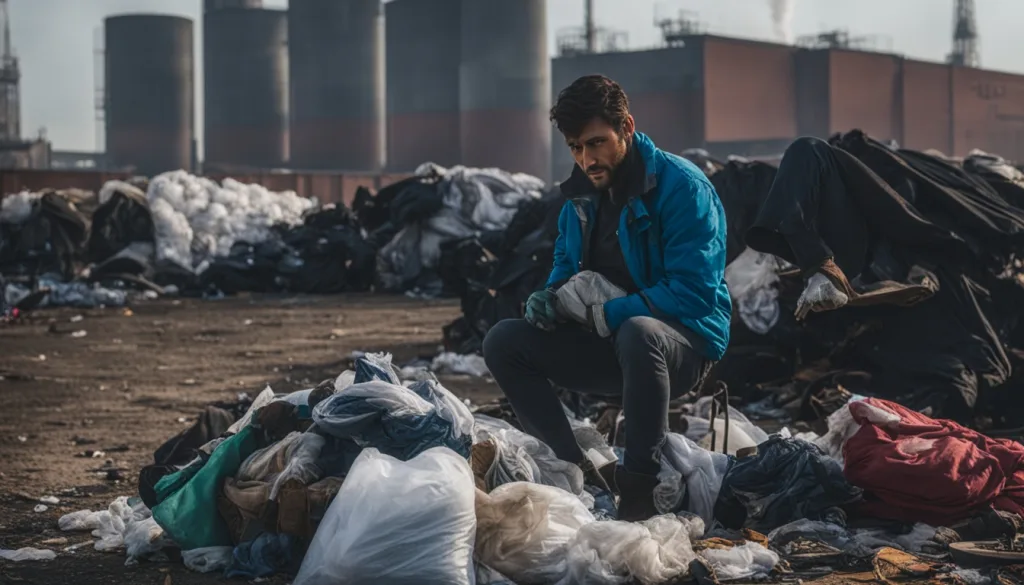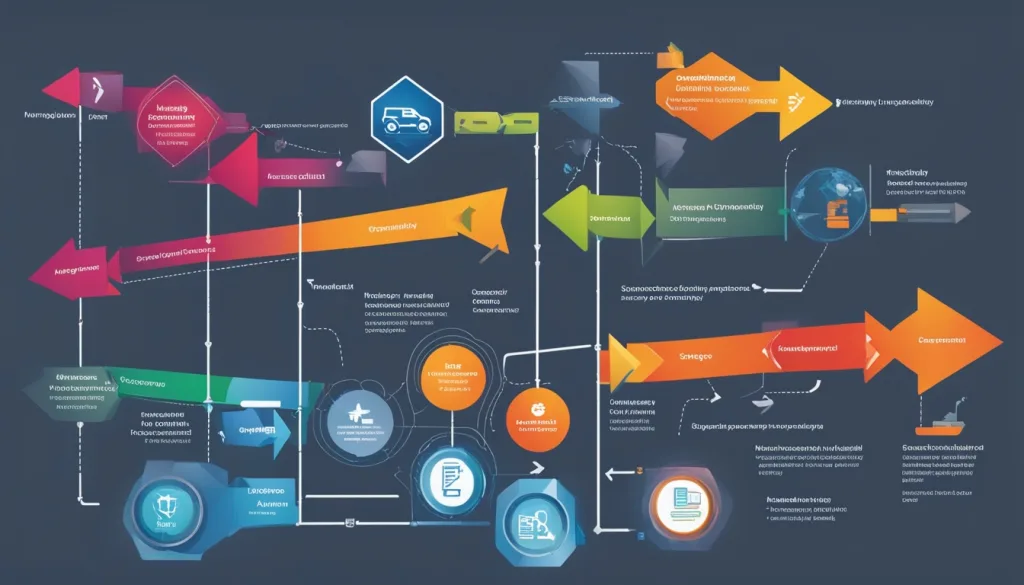The Role of Second-Hand Markets in Sportswear Sustainability
Connect With Us Today
Consider us for your next production run. Why wait? Send us your questions here.
The global secondhand market grew by 28% from $138 billion to $177 billion between 2021 and 2022. This jump shows a move towards eco-friendly sportswear and sustainable fashion1. Nowadays, the push for circular economy in sportswear is becoming stronger. The second-hand sportswear market could make up 10% of the global apparel market by 20241. Also, Generation Z is leading the way in sustainable sportswear choices. They mostly support brands that are eco-friendly, with nearly half not buying from those who don’t meet these standards1.
Today, sustainability in sportswear is more popular than ever. The second-hand market helps reduce the industry’s large carbon footprint, which is 2% to 8% of global emissions1. The UN Environment Program has highlighted the dangers of not reusing clothes – ending up in landfills or being burnt1. So, using second-hand markets is not just a trend. It’s a needed part of reaching a sustainable future.
Key Takeaways
- The big growth of the second-hand market points to a shift to sustainable fashion1.
- Second-hand sportswear is becoming a key part of the apparel market, supporting a circular economy in sportswear1.
- Generation Z’s push for sustainable fashion is shaping market trends and how brands act1.
- Choosing ethical and green consumer habits helps lessen the environmental harm from making sportswear1.
- The second-hand market is vital in reducing waste and the bad effects on the environment from the fashion industry1.
Embracing Thrift Culture: A Shift in Consumer Behavior
Thrift culture is growing, making it cool and smart to shop second-hand. This change is about more than saving money—it’s about being kind to our planet. As thrift stores and online marketplaces boom, we’re seeing a big shift in how people shop, aiming for a sustainable future.
Moving Beyond Stigma: Thrifting as a Sustainable Statement
Thrifting was once for those watching their budgets. Now, it’s a way to be eco-friendly. People are picking used items, showing they care about fashion’s effect on the earth. While green fashion is still a small part of the market2, it’s on the rise. Consumers want to stop the massive waste of clothes and the harmful microfibers reaching our oceans2.
The Millennial and Gen Z Impact on Second-Hand Apparel Markets
Millennials and Gen Z are making big waves in the second-hand market. They’re fighting against too much buying, knowing it harms our environment. They prefer quality over quantity, especially in activewear2. In Sweden, young folks are even more into second-hand, influenced by cost and quality3.
Consequences of Overconsumption Despite Second-Hand Popularity
Even with thrift shops’ success, overbuying is still an issue. Cheaper clothes lead to owning more but using them less. This cycle is bad for our planet2. The fast-fashion model encourages buying a lot quickly and then throwing it away. This can’t go on if we want a sustainable world, as this industry is hugely polluting3.
Matching our buying habits with environmental goals is tough2. But there’s hope. By embracing a circular economy, where items are reused, we make a big leap towards real sustainability3.
Evaluating Sustainability: The Double-Edged Sword of Thrifting

The trend of thrifting shines as a hopeful light for evaluating sustainability in today’s fashion scene. When people pick second-hand clothes, they skip the heavy energy use needed to make new clothes. This aims to cut down on the vast waste fashion creates. Yet, thrifting is a double-edged sword. It brings both good solutions and new problems for staying green.
For a more eco-friendly closet, many are shopping at places like TurnStyles Thrift Store and Savers. These spots have decent scores of 3.8 from 34 and 52 reviews4. On the other hand, The Salvation Army Family Store & Donation Center and City Thrift score lower, with 2.0 and 2.1 out of 54. This shows not all thrift shops meet people’s hopes, hinting at bigger issues in the thrift world.
The thrifting scene faces troubles with knowing where goods come from and buying too much. Clothz Minded’s high score of 4.6 from 49 reviews4 shows it blends demand with mindful shopping well. Yet, even with thrifting doing well, it doesn’t fully solve the issues of ethically sourcing goods and the risk of making more waste from buying too much.
Supporting thrift stores looks like a green move, but shoppers must stay alert and thoughtful. They must make sure their choices truly match up with their green and ethical goals4.
The Complex Reality Behind Second-Hand Sportswear Supply Chains
Looking closely at second-hand sportswear supply chains shows a complex picture. It’s not just about being green. Many steps in the process impact both the planet and the industry’s moral stance.
Invisible Journeys: Uncovering the Supply Chain of Pre-owned Garments
About 97% of clothes end up in dumps. And 60% of new clothes are trashed within a year5. Companies are now aiming to be more sustainable. For example, Renewcell wants to recycle over 1.4 billion t-shirts by 20305. This goal is a ray of hope. Companies like Levi Strauss and Adidas work with innovators. They’re making old clothes new again, like the famous 501 jeans5.
The Paradox of Local vs Global: Carbon Footprint in Second-Hand Trade
Local second-hand sportswear trade seems greener. But, the truth involves worldwide shipping, adding layers of complexity. Fashion contributes to 8% to 10% of the world’s greenhouse gases5. There’s a big need for clear supply chains. We must understand the environmental cost of clothing’s journey. By 2050, fashion might use 25% of the world’s carbon allowance5.
Assessing the Ethical Implications of Second-Hand Market Practices
Only less than 1% of textiles are turned into new clothes5. Yet, recycling textiles could bring in $100 billion each year5. Adidas is nearly there, using almost all recycled polyester. They aim for 100% by 2023, up from 96%5. Such actions change how supply chains work. They raise shoppers’ expectations and push for greener practices.

| Brand | Recycled Materials Usage | Annual Recycling Goal |
|---|---|---|
| Levi Strauss | 40% Renewcell fiber, 60% organic cotton | N/A |
| Adidas | 96% recycled polyester, aiming for 100% | N/A |
| Renewcell | Multiple fashion brand partners | More than 1.4 billion t-shirts recycled yearly by 2030 |
The journey through these supply chains reveals a truth. The second-hand sportswear market is alive and changing. It faces many hurdles. Yet, with clear goals, creative thinking, and a steadfast ethical stance, true sustainability is within reach.
The Role of Second-Hand Markets in Sportswear Sustainability
The secondhand market is growing fast, with a 28% increase from 2021 to 2022, reaching $177 billion1. In this growth, sportswear plays a key role. It is becoming popular due to the rise in upcycled sportswear and a shift towards eco-friendly sportswear.
Fast Fashion Versus Second-Hand: Assessing the Environmental Trade-Offs
Fast fashion accounts for 2% to 8% of the world’s carbon emissions1. In contrast, second-hand markets are much greener. Young shoppers, especially Generation Z, prefer brands that value sustainability, with 47% avoiding those that don’t1.
Sustainable Sportswear Consumption in the Era of Second-Hand Markets
The clothing industry’s impact on the environment is under close watch. Many are choosing sustainable habits. By 2024, secondhand clothing will be 10% of the world’s apparel market1. This shows how important pre-owned sportswear is in the push for sustainable living.
Upcycled and Pre-owned Sportswear: A Solution for Eco-Friendly Fitness
Vintage resale is booming. Top sellers at flea markets can make up to $1,000 on their best days1. Online sales are also strong, often beating physical store sales during peak times. This success shows how upcycled sportswear businesses can grow. It also shows more people are getting into vintage reselling, either full time or as a side job. This marks a positive change towards valuing second-hand sportswear economically1.
Conclusion
Exploring second-hand markets in sportswear sustainability is key to a greener and fairer fashion industry. The clothing sector’s worth is USD 1.3 trillion, involving more than 300 million people6. Our choices in clothes greatly influence economies and cultures around the world. The second-hand market helps clothes last longer. This counters the fact that a truckload of clothes is wasted every second6. It also backs the circular economy, which is a USD 560 billion chance to renew fashion6.
People are now choosing to rent clothes or buy durable ones. This shows we are starting to value long-lasting items over throwaway fashion6. New business models are making the most of this change. Clothing use is much higher in poorer countries than in places like the US6. This shows there’s big potential to make global consumption more balanced and resource-efficient.
By supporting sustainable choices, we can help limit the fashion industry’s carbon footprint for 20506. Choosing to use clothes more and support circular systems leads to a future where the economy grows without harming the planet. The growth of the second-hand market shows that sustainable sportswear is more than a passing fad. It’s a must for a responsible and fair fashion industry.
FAQ
What is the role of second-hand markets in sportswear sustainability?
How has thrift culture evolved from being stigmatized to becoming a sustainable statement?
How have millennials and Gen Z impacted the growth of the second-hand apparel market?
What are the consequences of overconsumption despite the popularity of second-hand clothing?
What are the benefits and challenges of buying second-hand clothing?
What are the complexities associated with second-hand sportswear supply chains?
What are the ethical implications of second-hand market practices?
How do fast fashion and second-hand clothing compare in terms of their environmental trade-offs?
How can consumers engage in sustainable sportswear consumption in the era of second-hand markets?
What is the role of upcycled and pre-owned sportswear in promoting eco-friendly fitness?
Source Links
- https://cronkitenews.azpbs.org/2023/12/08/vintage-resale-sustainable-business-fashion-enthusiasts/
- https://www.mdpi.com/1911-8074/15/4/176
- https://www.diva-portal.org/smash/get/diva2:1740367/FULLTEXT01.pdf
- https://www.yelp.com/search?find_desc=Goodwill Thrift Stores&find_loc=Overland Park, KS
- https://www.cnbc.com/2023/06/11/a-recycled-idea-at-levis-adidas-to-stop-clothing-from-going-to-waste.html
- https://www.ellenmacarthurfoundation.org/fashion-and-the-circular-economy-deep-dive
Latest News
How Collaboration Shapes Consumer Preferences in Sportswear
Navigating Consumer Rights and Warranties in Sportswear Sales
Artificial Intelligence in Fashion Forecasting and Trend Analysis
The Shift Towards Inclusive Sizing in Sportswear: Consumer Reactions
The Global Expansion of Luxury Sportswear Brands
From Sketch to Gym: The Design Process of Fashionable Sportswear
Understanding the Role of Trade Associations in Sportswear Compliance
How Economic Trends Influence Consumer Spending on Sportswear
Learning from Successful Global Market Entries
Best Practices for Managing Cross-Cultural Teams
Using Technology to Fight Counterfeit Fashion Products
Carbon Nanotube Fabrics for Superior Strength and Flexibility
The Growth of Fitness Tracking Apparel in Health and Wellness
Exploring the Influence of Social Proof in Sportswear Purchasing
Strategies for Managing Compliance in a Multinational Operation
Trends in Global Footwear: Performance Meets Lifestyle
The Role of Artificial Intelligence in Tracking Supply Chain Operations
Evaluating the Success of Sportswear Collaborative Projects
Evaluating the Potential of Emerging Markets
Global Shifts Towards Gender-Neutral Sportswear
Share This Article
Latest Articles



















